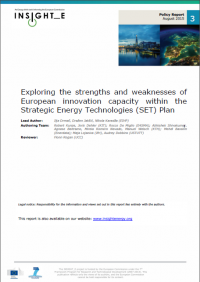Gateway to Think Tanks
| 来源类型 | Publications - External Publications - External Articles |
| 规范类型 | 其他 |
| Exploring the strengths and weaknesses of European innovation capacity within the Strategic Energy Technologies (SET) Plan INSIGHT_E Policy Report August 2015 | |
| lja DRMAC, Dražen JAKSIC, Nikola KARADZA, Maja LOJANICA | |
| 发表日期 | 2015-12-11 |
| 出版年 | 2015 |
| 概述 | The purpose of this policy report is to explore the strengths and weaknesses of European innovation capacity within the Strategic Energy Technologies (SET) Plan Integrated Roadmap. |
| 摘要 |
Exploring the strengths and weaknesses of European innovation capacity within the Strategic Energy Technologies (SET) Plan INSIGHT_E Policy Report August 2015
The purpose of this policy report is to explore the strengths and weaknesses of European innovation capacity within the Strategic Energy Technologies (SET) Plan Integrated Roadmap.  The SET Plan Integrated Roadmap groups energy technology priorities in to 13 themes for research and innovation (R&I). As a comprehensive European Energy R&I agenda, the thirteen themes of the Integrated Roadmap have been instrumental to determine the R&I priorities of the Energy Union. The Energy Union R&I priorities have been addressed in the recent Integrated SET Plan Communication, which proposes ten actions to accelerate the energy system transformation that have been identified on the basis of the Integrated Roadmap. Structured around the thirteen themes of the Integrated Roadmap, the aim of this report is to carry out an assessment of energy technology R&I in specific sectors and challenges in the EU. This is done by benchmarking cost, performance and market - readiness levels in relation to other regions of the world using data on the key companies, industries, and research institutes in the EU that are active in a particular area. The analysis is based on available literature and databases and compares the performance of the EU's Energy R&I sector versus other key countries worldwide on the basis of the following key research questions: 1. Based on existing indicators, which indicators can be used to measure the innovation capacity performance of the community in each sector? 2. Who are the key players in the 13 theme areas set out in the Integrated Roadmap, including companies, research institutes, universities and industries? 3. How does the community in Europe benchmark against other leading competitors in the world in the 13 themes? The SET Plan Integrated Roadmap provides the framework for the assessment of the state of play in each theme in Europe and summarises the challenges. Each Integrated Roadmap theme is discussed in a separate chapter in this policy report. A summary of the methodology employed to gather appropriate data on four key indicators to measure the innovation capacity is described in the next chapter. The four Integrated Challenges and thirteen themes of the SET Plan Integra ted Roadmap are as follows:
Theme 1: Engaging consumers through better understanding, information and market transformation Theme 2: Activating consumers through innovative technologies, products and services
Theme 4: Increasing energy efficiency in heating and cooling Theme 5: Increasing energy efficiency in industry and services
Theme 6:Modernising the European electricity grid and establishing synergies between the various energy networks Theme 7:Unlocking the potential of energy storage and conversion of electricity to other energy carriers Theme 8:Providing the energy system with flexibility, security and cost - effectiveness Theme 9: Development and demonstration of holistic system optimisation at local/urban level (Smart Cities and Communities)
Theme 10: Accelerating the development of renewable electricity an d heating/cooling technologies Theme 11: Enabling carbon capture, CO2 utilisation and storage technologies and increased efficiency of the fossil fuel - based power sector and energy intensive industry Theme 12: Supporting safe and efficient operation of nuclear systems, development of innovative reactor concepts and sustainable solutions for the management of fissile materials and radioactive waste Theme 13: Developing sustainable biofuels, fuel cells and hydrogen and alternative fuels for the European transport fuel mix Each of the subsequent chapters follow a similar structure, starting by describing each integrated challenge and their respective themes and then provide s an analysis of the strengths and weaknesses of each by drawing on publicly available data sources and stakeholder engagement. Each chapter concludes with an overview of Europe’s research and innovation capacity. The report concludes with a summary of the main conclusions from each integrated challenge
Exploring the strengths and weaknesses of European innovation capacity
|
| 关键词 | Innovation European Energy Policy European Union |
| URL | https://www.ifri.org/en/publications/publications-ifri/articles-ifri/exploring-strengths-and-weaknesses-european-innovation |
| 来源智库 | French Institute of International Relations (France) |
| 资源类型 | 智库出版物 |
| 条目标识符 | http://119.78.100.153/handle/2XGU8XDN/416098 |
| 推荐引用方式 GB/T 7714 | lja DRMAC, Dražen JAKSIC, Nikola KARADZA, Maja LOJANICA. Exploring the strengths and weaknesses of European innovation capacity within the Strategic Energy Technologies (SET) Plan INSIGHT_E Policy Report August 2015. 2015. |
| 条目包含的文件 | ||||||
| 文件名称/大小 | 资源类型 | 版本类型 | 开放类型 | 使用许可 | ||
| couv.insight_poilicy(41KB) | 智库出版物 | 限制开放 | CC BY-NC-SA |  浏览 | ||
| insight_e_eu_innovat(2086KB) | 智库出版物 | 限制开放 | CC BY-NC-SA | 浏览 | ||
除非特别说明,本系统中所有内容都受版权保护,并保留所有权利。